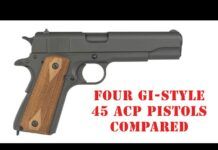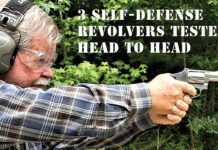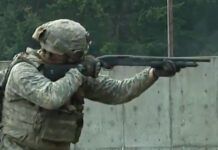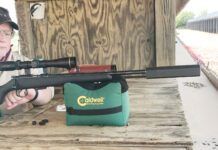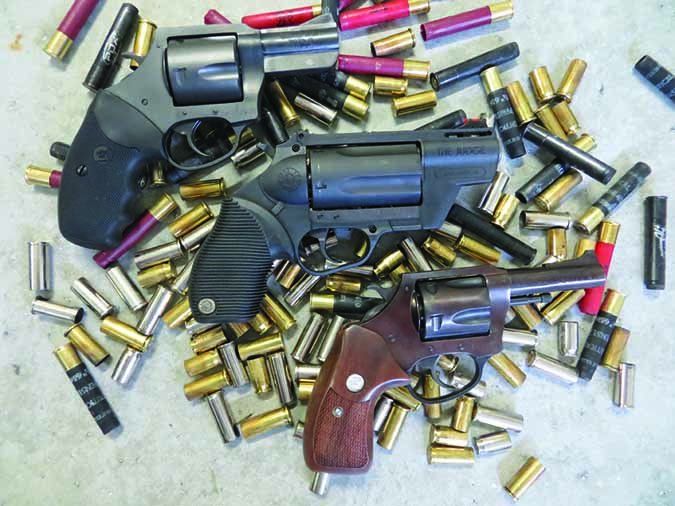
We recently reviewed three 38 Special revolvers that cost about $400 and thought we would increase our budget and caliber size, and then sourced three revolvers each costing about $500 in three different big-bore calibers: 44 Special, 45 ACP, and 45 Colt, often called 45 Long Colt (LC) to ensure it’s not mixed up with the Auto Colt cartridge. The three revolvers included two Charter Arms products, the Classic Bulldog in 44 Special and the newer Pitbull in 45 ACP, plus the Taurus Public Defender Polymer chambered in .410 shotshell and 45 LC.
Even though these were new revolvers, we still performed a range-rod test since there was a bit of side-to-side wiggle in the cylinders of all the revolvers. Range rods check the alignment of the chambers to the barrel bore. We also noted that the action of the Taurus seemed a bit stiff; our initial dry firing in double action found the cylinder would not fully index to the next chamber at times. Dry firing took care of the indexing issue, and all passed the range rod test. We also noted during the range-rod test the barrel of the Pitbull was not fully screwed into the frame. It was off by a fraction of a turn, enough to cock the front sight to the left when aiming the revolver. It is unacceptable that a gun leaves the factory in this condition. We anticipated and needed to use Kentucky windage with the Pitbull at the range.
Cartridge Range Data
| CHARTER ARMS BULLDOG CLASSIC 44 SPECIAL | HORNADY CLASSIC 44 SP. 180-GR. XTP | HSM 44 SP. 200-GR. RNFP | HORNADY CRITICAL DEFENSE 44 SP. 165-GR. FTX |
| Average velocity | 746 fps | 722 fps | 930 fps |
| Muzzle energy | 222 ft.-lbs. | 232 ft.-lbs. | 317 ft.-lbs. |
| Smallest group | 2.2 in. | 2.6 in. | 3.3 in. |
| Average group | 3.1 in. | 3.2 in. | 3.7 in. |
| CHARTER ARMS PITBULL 45 ACP | FEDERAL AMERICAN EAGLE 45 ACP 230-GR. FMJ | WINCHESTER DEFEND 45 ACP 230-GR. JHP | HPR 45 ACP 185-GR. JHP |
| Average velocity | 706 fps | 776 fps | 873 fps |
| Muzzle energy | 255 ft.-lbs. | 308 ft.-lbs. | 313 ft.-lbs. |
| Smallest group | 2.7 in. | 3 in. | 2.9 in. |
| Average group | 2.8 in. | 3.2 in. | 3.3 in. |
| TAURUS PDP 45 LONG COLT | FEDERAL AMERICAN EAGLE 45 LC 225-GR. JSP | HORNADY CRITICAL DEFENSE 45 LC 185-GR. FTX | WINCHESTER PDX1 DEFENDER 45 LC 225-GR. JHP |
| Average velocity | 786 fps | 860 fps | 764 fps |
| Muzzle energy | 309 ft.-lbs. | 304 ft.-lbs. | 292 ft.-lbs. |
| Smallest group | 1.6 in. | 2 in. | 2.2 in. |
| Average group | 2.2 in. | 2.6 in. | 2.8 in. |
| To collect accuracy data, we fired five-shot groups from a bench using a rest. Distance: 25 yards. We recorded velocities using a ProChrono digital chronograph set 15 feet from the muzzle. | |||
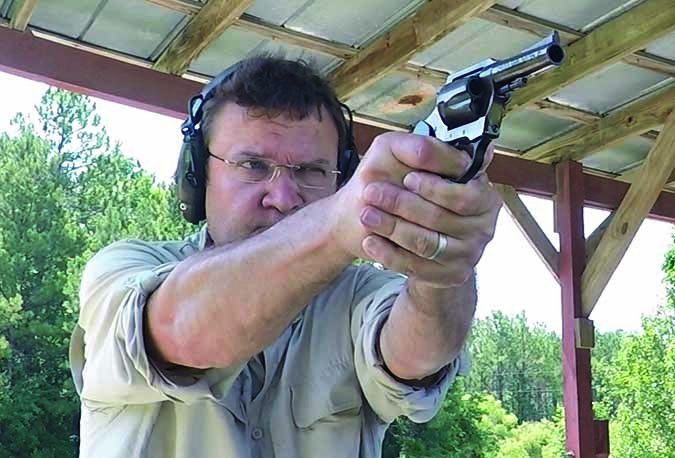
In the past Charter Arms revolvers have been favorably rated, but in these two examples we found exception. The not-fully-screwed-down barrel was also the reason the cylinder-to-barrel gap was so large. We measured the gap between the front of the cylinder and the forcing cone at the rear of the barrel using feeler gauges from Brownells (606-950-252WB) and found a gap of 0.010 inches for the Pitbull and the Bulldog Classic and the Taurus at 0.005 inch. A gap of 0.003 inches is desirable for a competition revolver, but up to 0.006 inches is often found. A large gap allows more gas to escape, reducing the bullet’s velocity. It also means there is more flash, and if the chamber and cylinder are not perfectly aligned, a user might experience splash from burning powders and bits of shaved bullet metal. We did not experience any splash with the Charter Arms revolvers. We did note that the Classic Bulldog had about 30 fps more than the published data for Hornady Critical Defense165-grain FTX bullet, which is 900 fps out of 2.5-inch barrel. The 3-inch barrel of Bulldog must have helped increase velocity. The Pitbull had noticeably less muzzle velocity compared to factory data. We assumed the reduction came because the Pitbull has a 2.5-inch barrel and the factory data for the cartridges use either a 4- or 5-inch barrel. Reduced muzzle velocity also occurred in the Taurus.
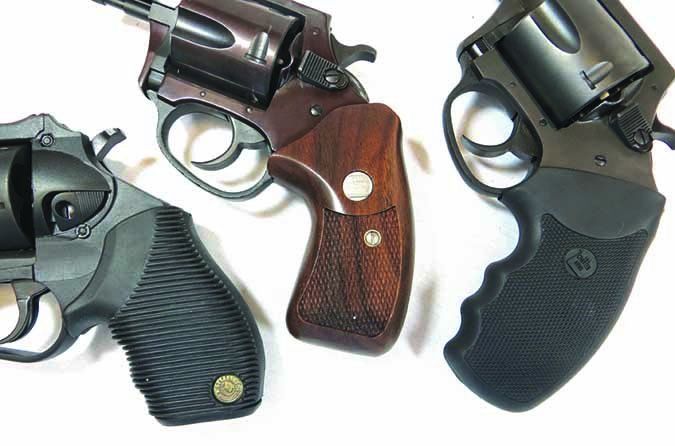
A common feature of all three revolvers was a safety transfer bar. This system prevents the hammer from striking the firing pin unless the trigger is pulled fully to the rear.
These revolvers are made for close-in work, but we still tested accuracy out to 25 yards. Since the Taurus offers the ability to fire .410 shotshells as well as cartridges, we sourced some CCI shot cartridges in 44 Special. CCI manufactures shotshells in 45 ACP, but warns against using the the cartridges in revolvers since the crimp that holds the shot in the cartridge case may interfere with the rotation of cylinder after being fired. One of our team members regularly carries a revolver loaded with bird shot cartridges and bullet cartridges when we walks his dog in the woods. He’s equipped to deal with snakes as well as bears, depending on what chamber he lets fly.
Shotshell Range Data
| WINCHESTER SUPER-X .410 BORE 000 BUCK | TAURUS PUBLIC DEFENDER POLYMER |
| Pattern size at 5 yards/10 yards | 5 in./8 in. |
| HORNADY CRITICAL DEFENSE .410 BORE ONE 41 CAL. SLUG, TWO 35 CAL. BALLS | |
| Pattern size at 5 yards/10 yards | 1.7 in./4 in. |
| WINCHESTER PDX1 DEFENDER .410 BORE, THREE DISCS | |
| Pattern size at 5 yards/10 yards | 1.1 in./11 in. |
| WINCHESTER PDX1 DEFENDER .410 BORE, 12 BBs | |
| Pattern size at 5 yards/10 yards Winchester PDX1 Defender loads include both discs and BBs. |
2.5 in./20 in. |
| AGUILA .410 BORE 1/2 OZ. #6 SHOT | |
| 5-yard pattern size | 26 in. |
| FEDERAL PERSONAL DEFENSE .410 BORE 7/16 OZ. #4 SHOT | |
| Pattern size | 23 in. |
| CCI 44 SPECIAL 1/4 OZ. #9 SHOT | CHARTER ARMS BULLDOG |
| Pattern size at 6 feet/12 feet | 8 in./18 in. |
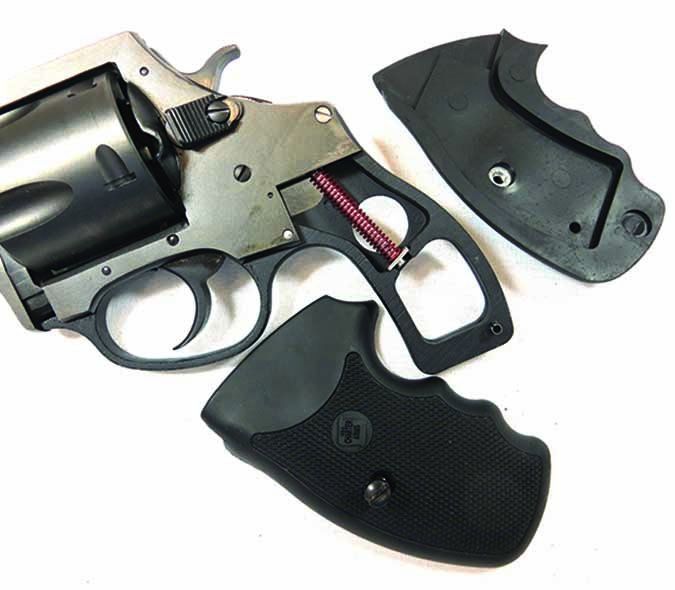
Obviously, the CCI cartridges do not have the power or range of a 410 shotshell, but in the situation when an ornery water moccasin claims your back yard as its new sunning space, we wanted a way to evict the viper. Part of our testing included how far we could shoot the 44 Special shot cartridges and .410 loads before the pattern became too large and ineffective. At close range, these shotshells have an advantage, but at longer ranges they become a liability. This is important to understand especially with a handgun like the Taurus, which fires .410 shells designed for defense. Imagine you are in a situation with bystanders and fire a shotshell. You may unintentionally hit bystanders. We acquired personal-defense shells from Hornady, Winchester, Federal, and target/hunting shells from Aguila to determine when the pattern of the load increased to a size where the pattern was larger than the intended target and projectiles hit unintended targets. We used a pair of 18-inch-wide targets set side by side in a CTK Precision P3 Ultimate Target Stand ($60; ctkprecision.com) to simulate a threat and a non-threat target and fired at one of the targets with the shotshells to determine what range the shot pattern was larger than the threat target and overlapped on the non-threat target. Here’s more of what we found testing these big-bore snubnose revolvers.
Charter Arms Pitbull Model 64520 45 ACP, $509
GUN TESTS GRADE: D
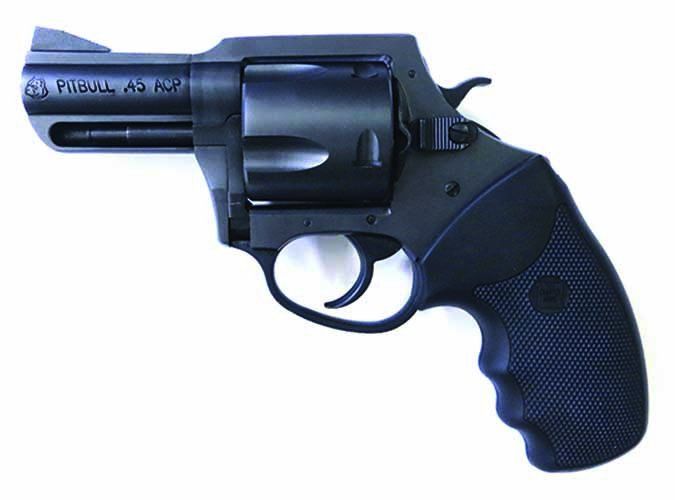
The Pitbull had a good finish and functioned as expected but the barrel was not fully seated. This big miss in Charter Arms’ quality-control process pushed this gun’s grade way down.
| ACTION TYPE | Double action |
| OVERALL LENGTH | 7.2 in. |
| BARREL LENGTH | 2.5 in. |
| SIGHT RADIUS | 4.2 in. |
| OVERALL HEIGHT | 5.1 in. |
| MAX WIDTH | 1.6 in. |
| WEIGHT UNLOADED | 22 oz. |
| WEIGHT LOADED | 24.5 oz. |
| CYLINDER GAP | .010 |
| CAPACITY | 5 |
| FRAME FINISH | Nitride |
| BARREL/CYLINDER FINISH | Nitride |
| FRAME FRONT STRAP HEIGHT | 1.6 in. |
| FRAME BACK STRAP HEIGHT | 3 in. |
| GRIP | Checkered rubber grooves |
| GRIP THICKNESS (max) | 1.2 in. |
| GRIP CIRCUMFERENCE (max) | 5 in. |
| FRONT SIGHT | Ramped blade |
| REAR SIGHT | Fixed groove |
| TRIGGER PULL WEIGHT (DA) | 12 lbs. |
| TRIGGER PULL WEIGHT (SA) | 5.5 lbs. |
| SAFETY | Internal transfer bar |
| WARRANTY | Limited lifetime warranty |
| TELEPHONE | (203) 922-1652 |
| WEBSITE | CharterArms.com |
| MADE IN | USA |
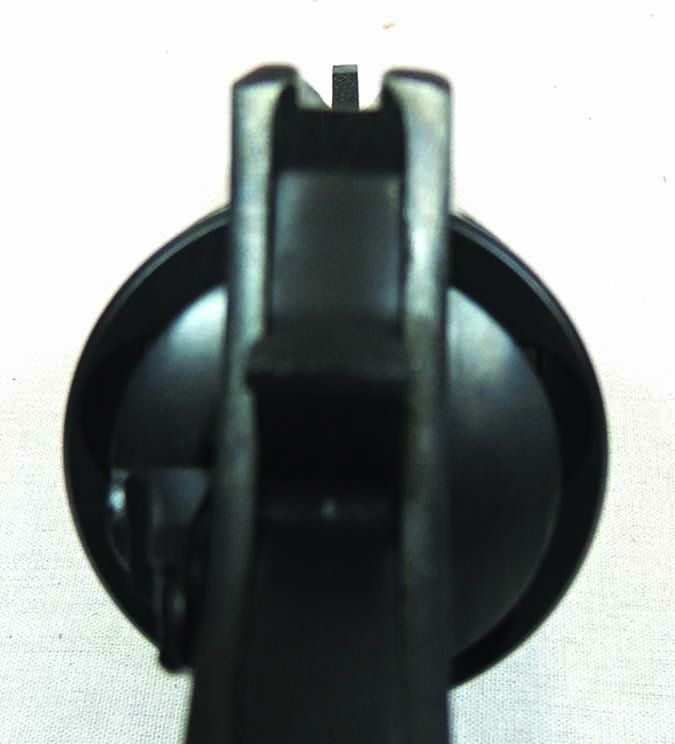
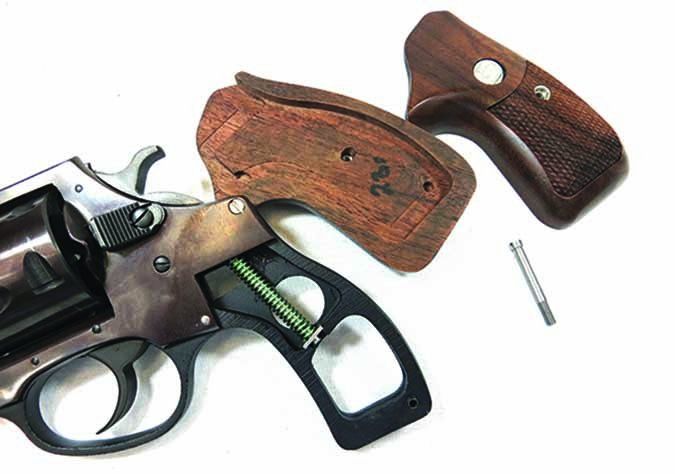
The Pitbull is the latest Charter Arms revolver designed to fire a rimless, semi-automatic pistol cartridge. This 5-shot model fires 45 ACP, and our testers liked the fact they could fire the same cartridge they use in their 1911 or other 45 ACP pistol in the Charter Arms. This is a stout, compact revolver made with a 416 stainless steel one-piece frame. The grip and trigger guard are made from an aluminum alloy. The stainless-steel barrel has the front-ramp sight milled out of the top side and, as mentioned, the barrel was not fully screwed into the frame. The rear sight is a groove milled along the top side of the frame. We felt these sights were usable, except for the crooked front sight. The ejector rests in a full lug under the barrel. The Charter Arms Bulldog Classic does not have a lug, and the ejector is exposed. The edge of the lug was rounded, making the revolver easier to holster. The cylinder edges were also chamfered to aid reholstering.
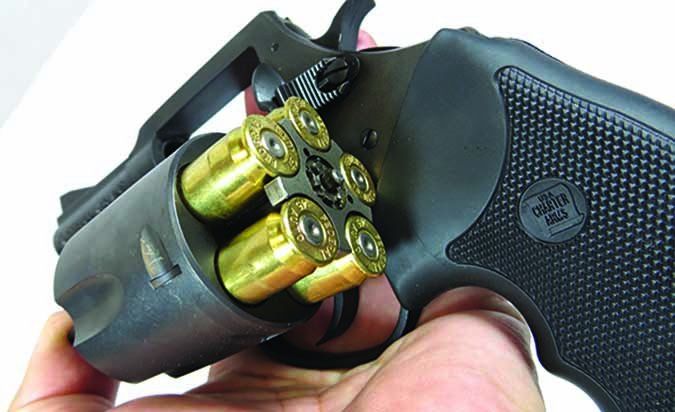
This Pitbull wears a new nitride finish that we felt was very well executed. The grips were typical checkered rubber with finger grooves, which is what we have come to expect with many Charter Arms revolvers. They fit our hands well, were thin, and helped reduce felt recoil. The grips did not interfere with unloading empty cases, an issue we had with the Bulldog Classic and Public Defender. Part of the reason is the 45 ACP cases are much shorter than the 44 Special and 45 LC cases.
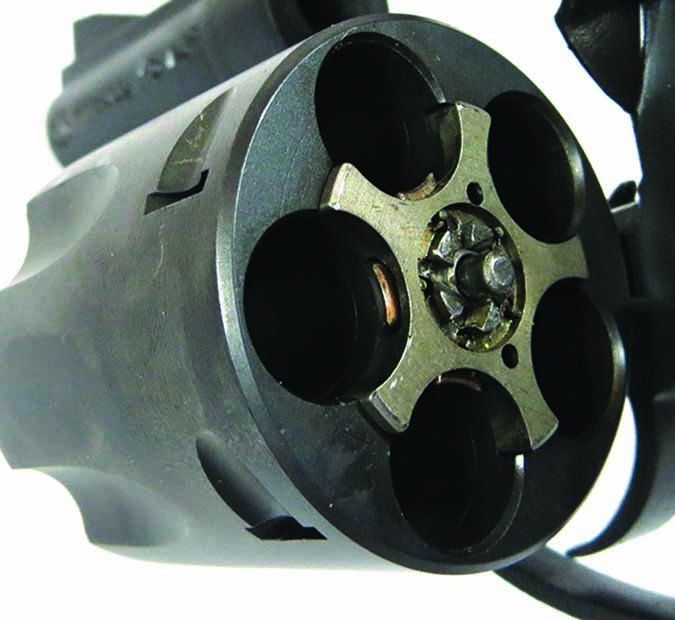
The double-action trigger was a bit gritty to start, but smoothed up after use and measured 12 pounds. In single-action mode, the trigger broke at 5.5 pounds. The trigger was serviceable and we felt suitable for a defensive handgun. The revolver was also easy to manipulate — cocking the hammer, lowering the hammer, opening the cylinder — without requiring strong hand muscles. The trigger is serrated so your finger does not slip when pressing back in double action. The unique feature of the Pitbull series is the ejector has a built-in spring-loaded plunger for each chamber that is depressed when a cartridge is inserted into the chamber and snaps back out into the extractor groove of the rimless cartridge case. This system elminates the need for moon clips. The chambers are also stepped, so 45 ACP cases headspace on the case mouth.
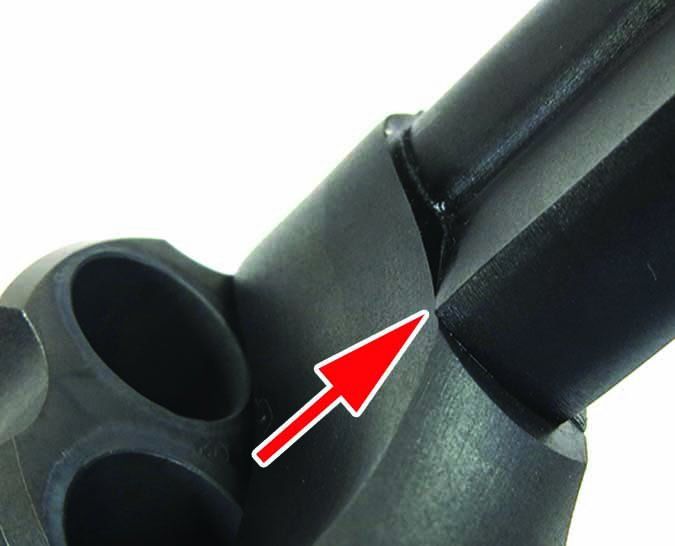
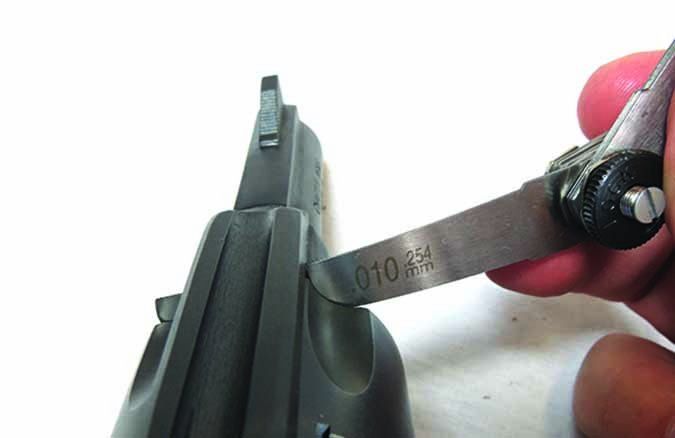
At the range the Pitbull, shot to the left, as expected, so we used Kentucky windage to test accuracy, and we found with ball and JHP ammo, this revolver could consistently shoot 3-inch 5-shot groups. We noticed the most felt recoil with cartridges in the Pitbull due to the narrow rubber grip. It was tolerable but noticeable. The Pitbull had the longest grip, which made it easier to shoot but harder to conceal. We also noticed that loading the 230-grain FMJ American Eagle brand ammo, we needed to ensure the ejector was depressed to insert the the round. The other 45 ACP cartridges were much easier to insert into the chambers. We also smartly pressed the ejector rod to see if the ejector would slip past the empty cases and found we could only trip up the Pitbull once. In that instance, we needed a screwdriver or other slender object to act as a tool to eject the case.
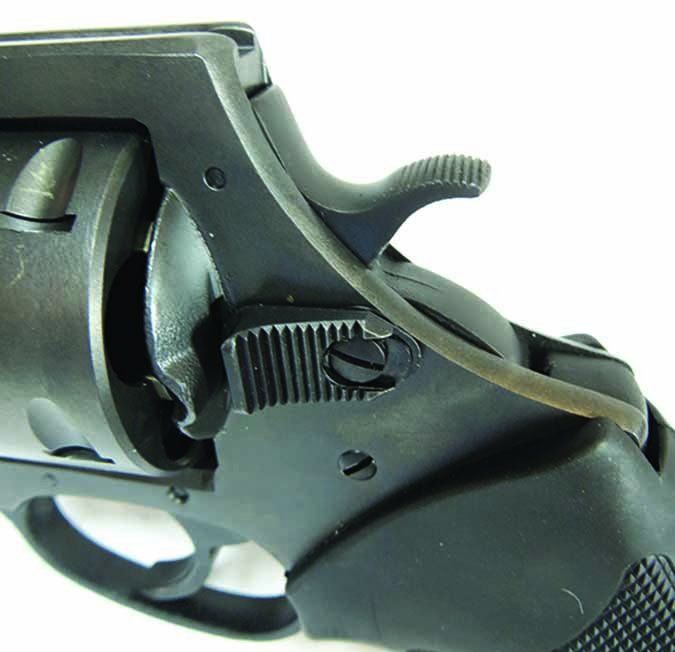
Our Team Said: The Pitbull was easy to use and like. If it was not for the improperly installed barrel, the Pitbull would have rated much higher.
Charter Arms Bulldog Classic Model 34431 44 Special, $436
GUN TESTS GRADE: B-
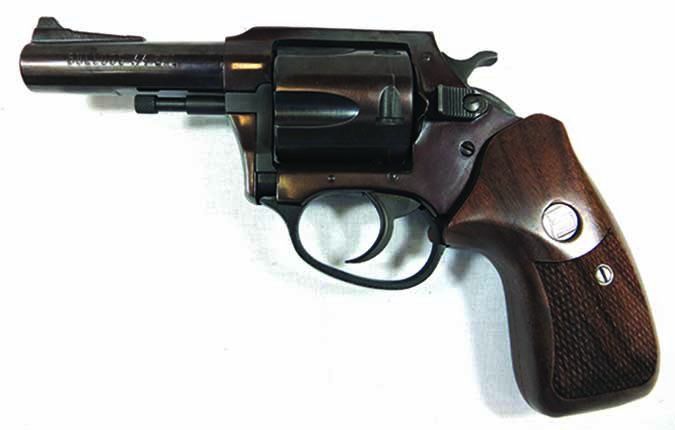
The Bulldog had good accuracy for such a small revolver. The double-action trigger was smooth. The wood grip fit was loose and unacceptable.
| ACTION TYPE | DA/SA |
| OVERALL LENGTH | 7.5 in. |
| BARREL LENGTH | 3 in. |
| SIGHT RADIUS | 4.7 in. |
| OVERALL HEIGHT | 4.7 in. |
| MAX WIDTH | 1.4 in. |
| WEIGHT UNLOADED | 20 oz. |
| WEIGHT LOADED | 22.7 oz. |
| CYLINDER GAP | .010 in. |
| CAPACITY | 5 |
| FRAME FINISH | Black |
| BARREL/CYLINDER FINISH | Black |
| FRAME FRONT STRAP HEIGHT | 2.1 in. |
| FRAME BACK STRAP HEIGHT | 3.2 in. |
| GRIP | Checkered wood |
| GRIP THICKNESS (max) | 1.2 in. |
| GRIP CIRCUMFERENCE (max) | 4.8 in. |
| FRONT SIGHT | Ramped blade |
| REAR SIGHT | Fixed groove |
| TRIGGER PULL WEIGHT (DA) | 13 lbs. |
| TRIGGER PULL WEIGHT (SA) | 3.2 lbs. |
| SAFETY | Internal transfer bar |
| WARRANTY | Limited lifetime warranty |
| TELEPHONE | (203) 922-1652 |
| WEBSITE | CharterArms.com |
| MADE IN | USA |
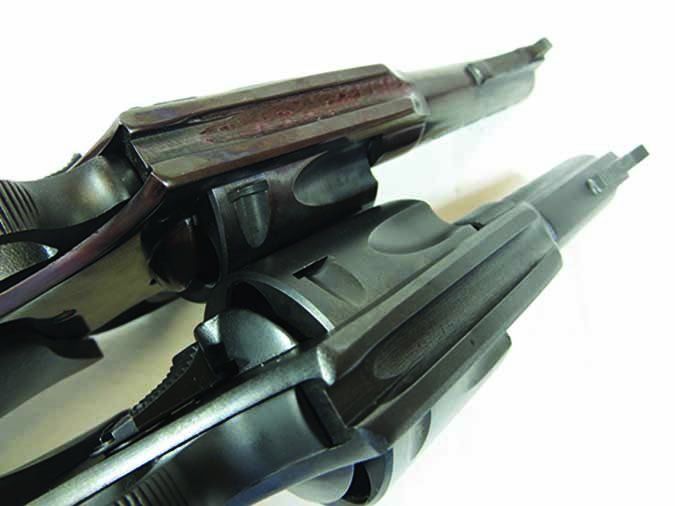
The Bulldog Classic is Charter Arms’ iconic revolver, first manufactured in 1973. It looks old school with the tapered 3-inch barrel, exposed ejector rod, and checkered walnut grips. We liked this revolver from the get-go due to its compact size and 44 Special chambering.
Testers who have had Bulldog revolvers noted the finish color was a purplish blue. The finish of older revolvers changes over time due to the alloy frame turning purplish, while the barrel and cylinder stayed a dark blue. In hand, this is a lightweight revolver, feeling a lot like a 38 Special except for the fatter cylinder, which holds five rounds of 44 Special. We noticed the nicely-shaped wood grip wiggled on the grip frame, so we tightened the grip screw, but to no avail. A shim would be needed to take up the space between the metal grip frame and the inside of the grip. Again, this is another ding on Charter Arms for allowing a revolver through QA with a wobbly grip. We found another issue with the Bulldog’s finishing, too. The groove in the top strap, which acts as the rear sight, looked like it was ground out with a Dremel tool and then finished. The rest of the revolver had a nice polished look, but the rear-sight groove looked rough.
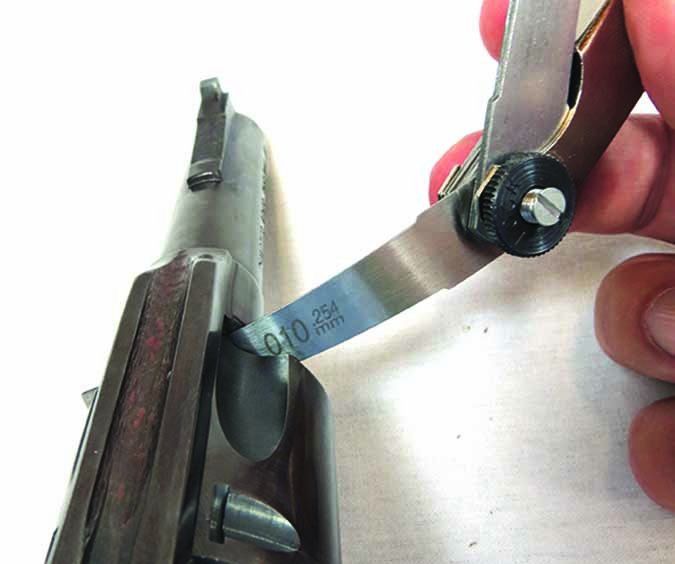
The wood grip was just large enough to help dissipate recoil into the palm of our hands, yet still be very concealable. The checkering was fine, and as mentioned, the grips were loose, which we knew would not help in accuracy testing. We expected the grip to crack during testing, because it was so loose the metal frame moved position each time the revolver was fired.
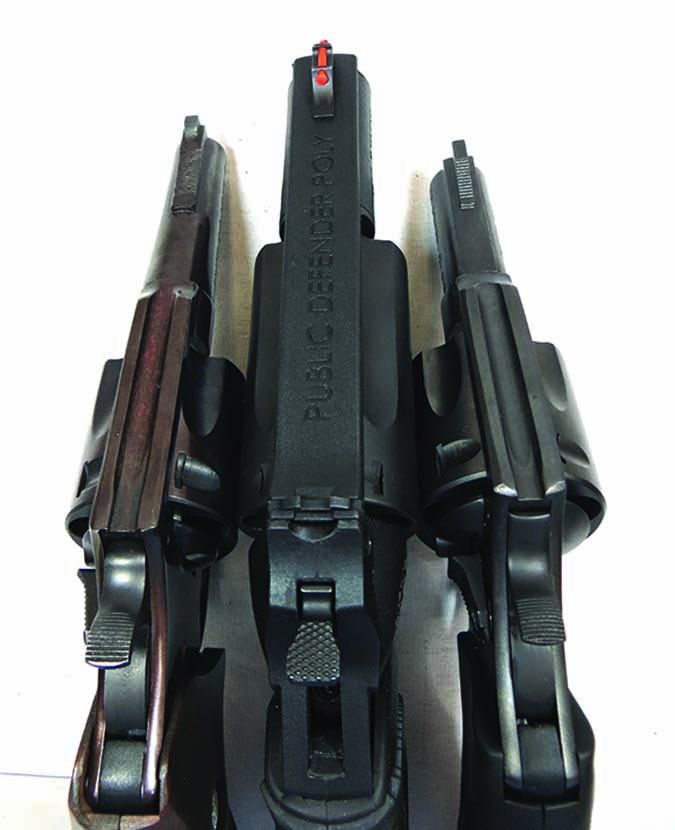
The double-action trigger had a pull weight of about 13 pounds; single action was about 3.2 pounds. The trigger was grooved, so even in recoil our finger stayed put. In DA mode for all three revolvers, we felt stacking. The serrated cylinder latch slides forward to open the cylinder, though you could pull forward on the ejector rod to gain access to the cylinder’s chambers. A slight ring appeared around the cylinder after dry firing and testing, as did with the other two revolvers.
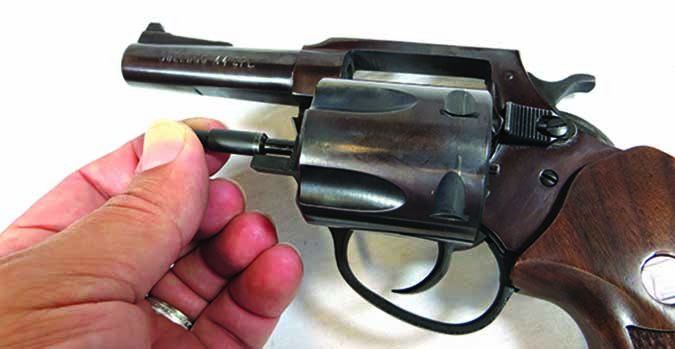
At the range the Bulldog felt surprisingly small and compact to hold five 44 Special cartridges. Using a rest at 25 yards, we were pleasantly surprised to get 3-inch average groups with five rounds. The 25-yard accuracy test is much farther than the distance you would typically be expected to use these revolvers, but we wanted to push the limits of these snubnoses. With the Hornady Classic 180-grain XTP round, we were able to shoot a 2.2-inch 5-shot group at 25 yards using a rest. That was excellent considering the revolver was compact and had fixed sights. At closer ranges we were able to get some excellent groups. The fuller and slightly fatter grip made the Bulldog pleasant to shoot. Remember, this lightweight revolver does not have much weight to help absorb recoil. In fact, it was the lightest of all three guns tested. To add versatility to the Bulldog, we fired some CCI 0.25-ounce #9 shot cartridges at 6 feet — about as close as you would want to get to a copperhead or cottonmouth — and found we could get a pattern of about 8 inches across, about the size of a paper plate. As we went farther out, the pattern grew increasingly larger, as expected, so much so that at twice the distance, 12 feet, the pattern was not very dense. We would use the CCI shot loads only on snakes and perhaps rats. On larger vermin, the rounds would not have the desired killing effect.
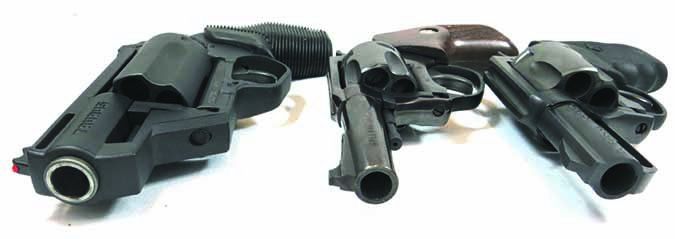
We found more not to like about the grip when ejecting empties. If we pressed the ejector rod fully out, one of the empty cases would get trapped by the edge of the grip. These snubnoses are more “get away” pistols, allowing you to fire at close range and get to safety, so a fast reload may not be required. But we still feel that the wood grip, as much as it felt good in hand, was a liability. We’d deep-six the factory wood grip and get an aftermarket wood or rubber grip with similar dimensions.
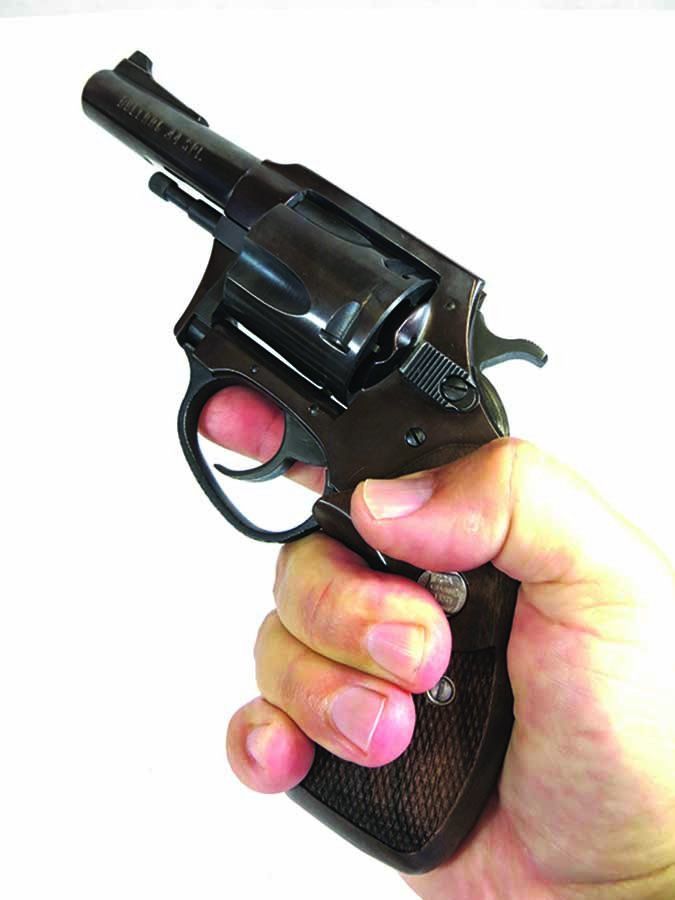
For the concealed-carry portion of the test, we used holsters designed for a S&W J-frame to tote both Charter Arms revolvers and found the size and weight of the Bulldog was the most comfortable. We had no available holster to tote the Taurus other than a shoulder holster, but then again the Taurus is a wholly different revolver experience.
Our Team Said: The Bulldog is a compact, accurate, and inexpensive defensive revolver, but the wobbly grip and rough-looking rear sight groove caused us to grade it lower.
Taurus Public Defender Polymer Model 4510PLYFS .410/45 Long Colt, $514
GUN TESTS GRADE: A-
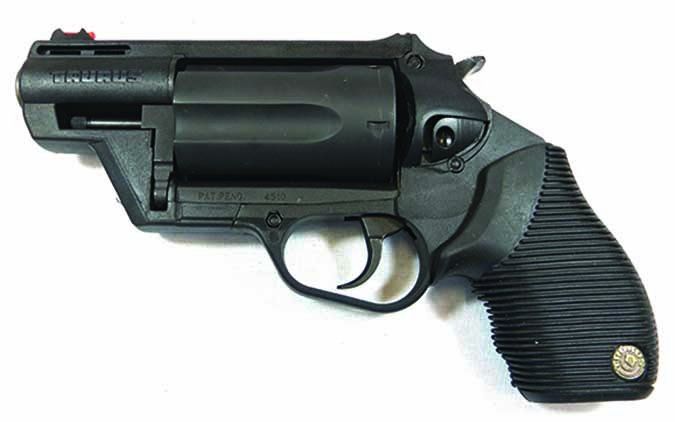
The Public Defender offers versatility along with good accuracy. It had good balance for such an awkward-looking revolver.
| ACTION TYPE | Double action |
| OVERALL LENGTH | 7.6 in. |
| BARREL LENGTH | 2 in. |
| SIGHT RADIUS | 4.1 in. |
| OVERALL HEIGHT | 4.6 in. |
| MAX WIDTH | 1.5 in. |
| WEIGHT UNLOADED | 27 oz. |
| WEIGHT LOADED | 29.7-30.1 oz. (depends on load) |
| CYLINDER GAP | 0.005 in. |
| CAPACITY | 5 |
| FRAME FINISH | Black |
| BARREL/CYLINDER FINISH | Black |
| FRAME FRONT STRAP HEIGHT | 1.6 in. |
| FRAME BACK STRAP HEIGHT | 3 in. |
| GRIP | Ribbed rubber |
| GRIP THICKNESS (max) | 1.1 in. |
| GRIP CIRCUMFERENCE (max) | 5.2 in. |
| FRONT SIGHT | Red fiber optic |
| REAR SIGHT | Windage adjustable notch |
| TRIGGER PULL WEIGHT (DA) | 13 lbs. |
| TRIGGER PULL WEIGHT (SA) | 6 lbs. |
| SAFETY | Internal transer bar |
| WARRANTY | Lifetime limited warranty |
| TELEPHONE | (800) 327-3776 |
| WEBSITE | TaurusUSA.com |
| MADE IN | Brazil |
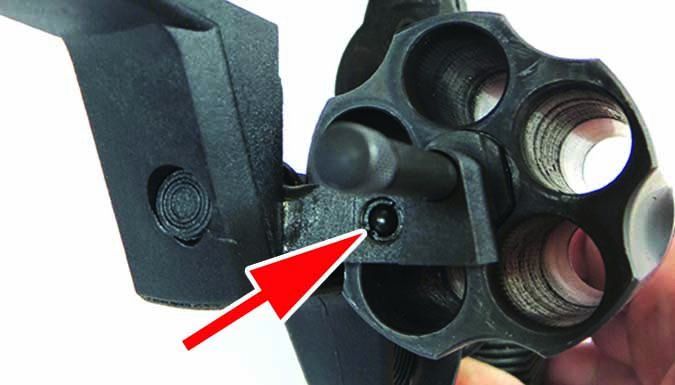
The Polymer Public Defender is an awkward looking revolver until you pick it up and hold it. The Public Defender has nice balance, but don’t think this is as compact as either of the Charter Arms revolvers. The Taurus is large, and unlike the Judge, which the Public Defender is derived from, the Public Defender is as compact a revolver as you can get, especially with a cylinder that is chambered for 2.5-inch-long .410 shotshells. The barrel is a stubby 2 inches, and the ribbed rubber grip is as compact as Taurus’s CIA J-frame clone.
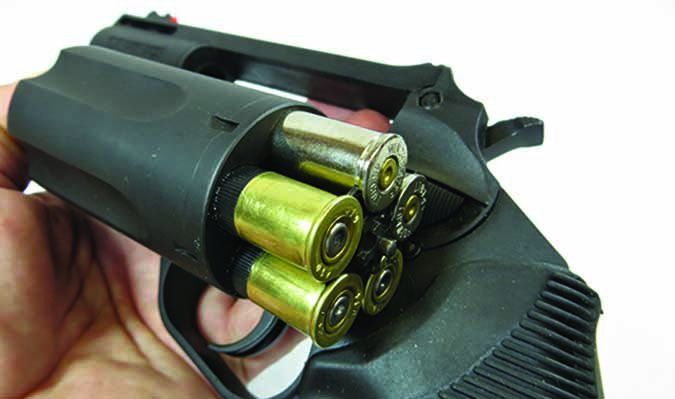
As the name implied, the Polymer Public Defender is constructed with a polymer frame and polymer grip, which dramatically reduces the weight of the revolver compared to the steel-frame Judge. A steel barrel and cylinder window is imbedded into the polymer. The frame and grip are screwed together similar to how the Ruger LCR is built. The Public Defender is a large snubnose, and in our opinion, it is very manageable in tight spaces, like the inside of a vehicle. The Taurus has a cylinder that is nearly twice the length of either Charters Arms cylinders. That longer cylinder makes the Taurus versatile, as it can fire .410-bore shotshells and 45 LC cartridges.
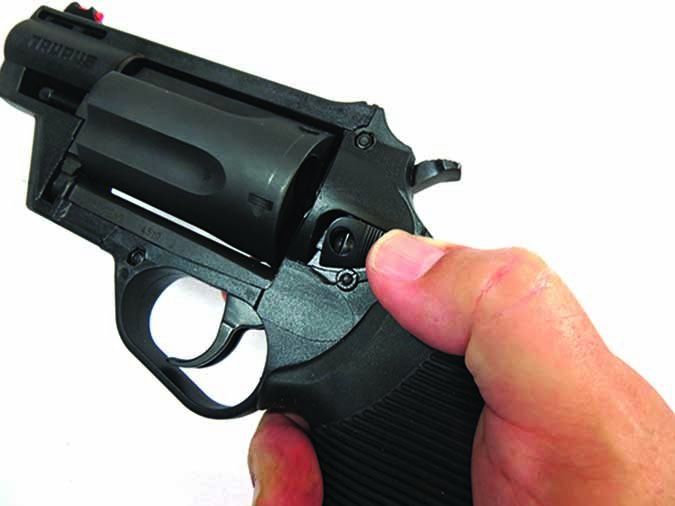
Unlike the other revolvers tested, the Taurus has a windage-adjustable rear sight. The front sight is a fiber optic unit. These sights offered the best sight picture of all three guns. Under recoil, the fiber-optic tube loosened, and if left as is, would most likely be lost.
To load the Public Defender, the cylinder latch, which is built into the oversized recoil shield, is pressed forward. The latch is serrated, flush with the shield, and on the bottom portion of the shield, so you had to pay attention and get a good purchase on it to operate. We felt the revolver was built well, with the crane having a detent ball that snapped into place in the metal frame.
The trigger weight measured about 13 pounds in double action and 6 pounds in single-action mode. The trigger has a smooth face. The hammer was easy to cock back, and it was mostly concealed by the large recoil shield. Taurus made an effort to ensure the Public Defender was snag free. The tiny compact grip was ribbed and had finger grooves. Most team members had to curl their small finger under the butt. It felt good in hand and was very pointable. As we spent time with the Public Defender, we liked how it performed and admired its versatility.
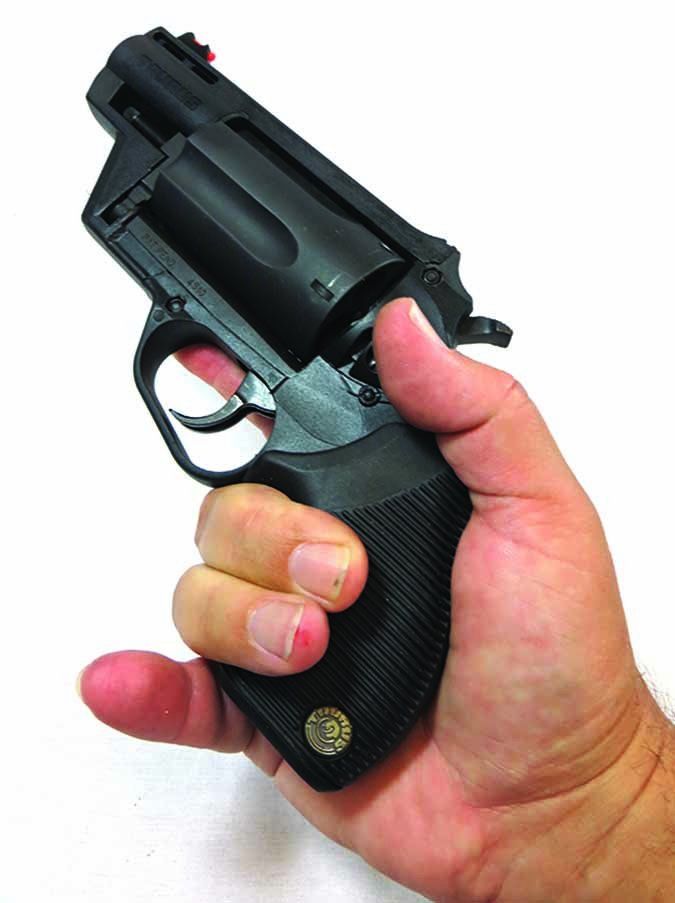
At 25 yards using a rest, we started off with 45 LC cartridges and were pleased with the 5-shot groups. With Federal American Eagle 225-gr. JSP ammo, the Taurus gave us a best 5-shot group of 1.6 inches. On average with Hornady Critical Defense 185-gr. FTX bullets and Winchester PDX1 Defender 225-gr. JHP bullets, we averaged just under 3 inches for 5-shot groups. The heft of the revolver made recoil of the 45 LC cartridges manageable. When we moved to the .410 shells we experienced more recoil.
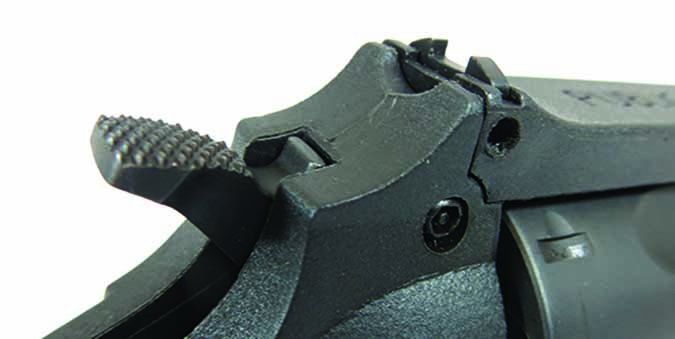
Many ammunition manufacturers have produced defensive .410 shotshells specifically for .410 revolvers, so we acquired some Critical Defense from Hornady, which uses one 41-caliber FTX slug and two 35-caliber ball projectiles, and some PDX1 Defender from Winchester that is loaded with three discs and 12 BB shot, and Federal Personal Defense, which is loaded with 7⁄16-oz. of #4 shot. We also tried some Winchester Super-X 000 buck and a target load from Aguila loaded with a half-ounce of #4 shot. At close range, the defense loads produced some tight patterns. The Aguila target load had the largest pattern, and we would reserve that for snake eradication. At 5 yards, this shotshell sent a dense powerful blast. It was a lot louder than the CCI 44 Special shotshell cartridges, but the need for a follow up shot is greatly reduced. For self-defense, the loads gave us impressive patterns at close range. At 5 yards we were able to keep the Hornady Critical Defense and Winchester Super-X 000 buck on one of the side-by-side targets. The Hornady had a 1.7-inch pattern and the Winchester 000 buck measured 5 inches. The large projectiles from Winchester PDX1 Defender shotshells patterned nicely on the threat target at 1.1 inches, but the non-threat target was splashed with pellets. The BBs created an 11-inch pattern. We had similar results with the Federal Personal Defense #4 shot and Aguila loads, 26- and 23 inches, respectively. As we moved the target farther away to 10 yards, the pattern sizes naturally increased, with the Hornady creating a 4-inch pattern. Winchester 000 created an 8-inch pattern, and the Winchester PDX1 Defender loads created a 2.5-inch pattern with the discs and a 20-inch pattern with the BBs. Be aware that at longer distances, shotshell loads disperse and are less effective on the intended target and may accidentally hit bystanders. Remember, you have better control over a bullet than a shotshell. In our opinion, at closer distances defensive 410 shotshells can be effective.
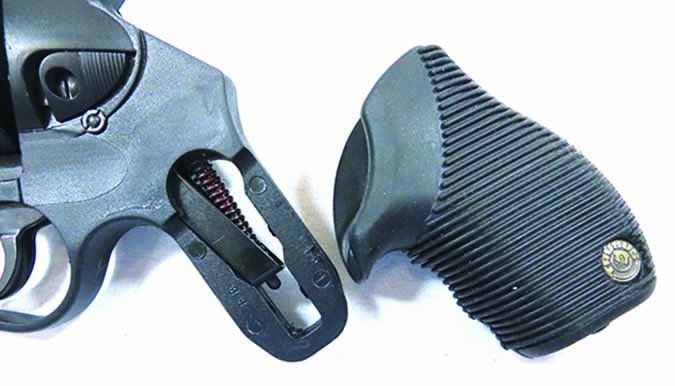
We did note that the Aguila and Federal shotshells had to be pressed into the chambers, while the Winchester and Hornady shells dropped into the chambers like a cartridge. Shells not fully seated in the chamber did not allow the cylinder to be closed, or if partially seated, did not allow the cylinder to rotate. When ejecting the shells, the defense loads were the easiest to expel. The target loads, however, required us to tap the ejector rod against the wooden shooting bench to pop them out of the chamber. Also, since the shells are so long, the shell closest to the grip when the cylinder is open gets hung up, requiring the user to rotate the cylinder to fully remove the shell.
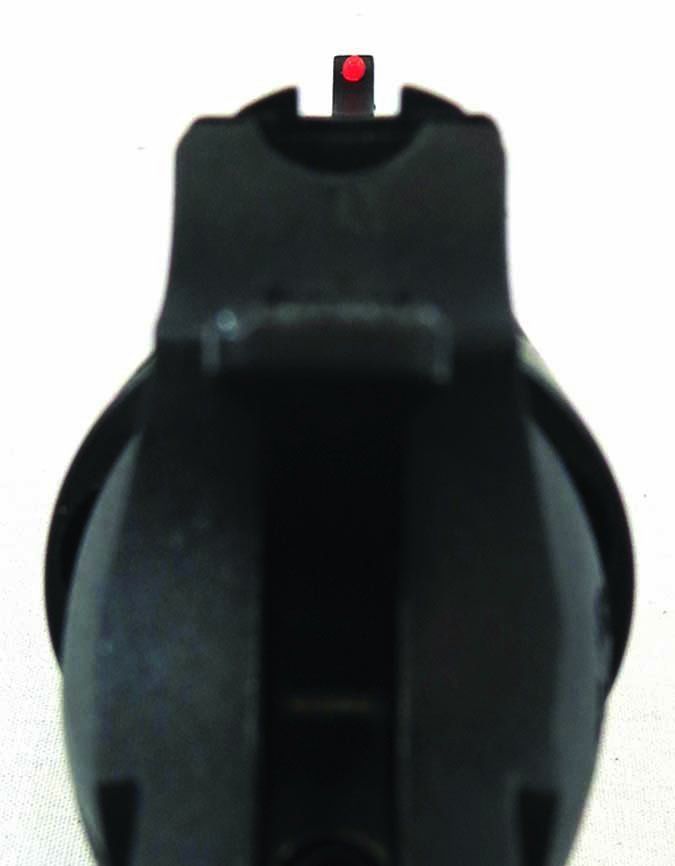
The trade off with the Taurus’ versatility is its poor ability to be concealed. The Public Defender is a heavy, large handgun made as compact as possible, but it is still larger than most 5-shot concealable revolvers. We carried the Taurus in a shoulder holster, which was fine for jacket and coat weather, but not when it is warm.
Our Team Said: The Public Defender is versatile, being able to fire .410 shells and 45 LC cartridges. If you are looking for a large-bore revolver for concealed carry, the Taurus may be too large for average-size concealed-carry-license holders. It does make sense for vehicle and nightstand use.
Written and photographed by Robert Sadowski, using evaluations from Gun Tests team testers.




